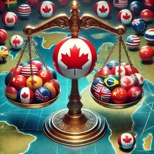Negotiation, Bargaining Power, and Canada’s Need to Diversify Trade
Tuesday, February 04, 2025 - Filed in: General Interest

I’ve seen this play out in labour disputes, contract negotiations, and commercial dealings. And I see it happening on a much larger scale when it comes to Canada’s trade policies.
Canada’s Trade Dependence and the Power Imbalance It Creates
Canada is a trading nation. Our economy thrives on exporting natural resources, agricultural products, and manufactured goods while importing critical supplies from abroad. But a closer look at our trade relationships reveals a concerning reality: we are heavily dependent on a small number of partners, particularly the United States.
From my years of experience in negotiation and dispute resolution, I know that when one party relies too much on another, their ability to secure fair terms weakens. That’s exactly the position Canada finds itself in. When our largest trading partner imposes tariffs, changes regulations, or prioritizes its own industries, Canadian businesses often find themselves with little recourse. We’ve seen it before with softwood lumber disputes, restrictions on agricultural exports, and global supply chain disruptions.
On the flip side, Canada’s reliance on specific countries for imports—whether for medical supplies, technology, or manufacturing components—also puts us in a vulnerable position. When a single supplier controls a critical resource, costs rise, availability diminishes, and Canadian businesses suffer the consequences. The pandemic exposed just how fragile these supply chains can be.
The Path Forward: Strength Through Diversification
In my role as a neutral, I regularly help parties find solutions that balance competing interests and create stability. One of the most important lessons I’ve learned is that the best way to protect against uncertainty is to have options. The same principle applies to Canada’s economy. If we want to avoid being at the mercy of foreign policy shifts or global crises, we need to diversify both our imports and exports.
By expanding our trade relationships, we can:
I am not suggesting we turn away from our key trading partners. Instead, we must be proactive in expanding our markets, forging new agreements, and ensuring that Canadian businesses have the flexibility to navigate changing global conditions.
Why This Needs to Be a Federal Election Issue
With a federal election approaching, Canadians should be asking where each party stands on trade diversification. Political leaders must present clear strategies to strengthen our economic position, protect Canadian jobs, and ensure that our country never finds itself in a weak bargaining position.
For over four decades, I have worked to help parties find balance in negotiations—whether in labour disputes, commercial dealings, or complex legal matters. Whether in business, law, or global trade, one thing remains true—having options is the best way to secure a fair deal.
It’s time for Canada to take control of its economic future. Let’s make sure trade diversification is at the forefront of the next federal election.
Canada is a trading nation. Our economy thrives on exporting natural resources, agricultural products, and manufactured goods while importing critical supplies from abroad. But a closer look at our trade relationships reveals a concerning reality: we are heavily dependent on a small number of partners, particularly the United States.
From my years of experience in negotiation and dispute resolution, I know that when one party relies too much on another, their ability to secure fair terms weakens. That’s exactly the position Canada finds itself in. When our largest trading partner imposes tariffs, changes regulations, or prioritizes its own industries, Canadian businesses often find themselves with little recourse. We’ve seen it before with softwood lumber disputes, restrictions on agricultural exports, and global supply chain disruptions.
On the flip side, Canada’s reliance on specific countries for imports—whether for medical supplies, technology, or manufacturing components—also puts us in a vulnerable position. When a single supplier controls a critical resource, costs rise, availability diminishes, and Canadian businesses suffer the consequences. The pandemic exposed just how fragile these supply chains can be.
The Path Forward: Strength Through Diversification
In my role as a neutral, I regularly help parties find solutions that balance competing interests and create stability. One of the most important lessons I’ve learned is that the best way to protect against uncertainty is to have options. The same principle applies to Canada’s economy. If we want to avoid being at the mercy of foreign policy shifts or global crises, we need to diversify both our imports and exports.
By expanding our trade relationships, we can:
- Strengthen Our Bargaining Power – More trading partners mean more negotiating leverage, ensuring Canada isn’t overly reliant on any single country.
- Secure Canadian Jobs and Businesses – If one market becomes unstable or restrictive, Canadian businesses need alternative buyers to keep their operations running.
- Promote Domestic Growth – A diversified trade strategy should also include strengthening our own manufacturing capabilities to reduce dependency on foreign suppliers.
I am not suggesting we turn away from our key trading partners. Instead, we must be proactive in expanding our markets, forging new agreements, and ensuring that Canadian businesses have the flexibility to navigate changing global conditions.
Why This Needs to Be a Federal Election Issue
With a federal election approaching, Canadians should be asking where each party stands on trade diversification. Political leaders must present clear strategies to strengthen our economic position, protect Canadian jobs, and ensure that our country never finds itself in a weak bargaining position.
For over four decades, I have worked to help parties find balance in negotiations—whether in labour disputes, commercial dealings, or complex legal matters. Whether in business, law, or global trade, one thing remains true—having options is the best way to secure a fair deal.
It’s time for Canada to take control of its economic future. Let’s make sure trade diversification is at the forefront of the next federal election.


